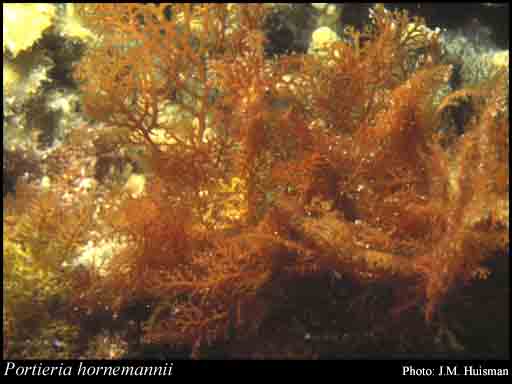- Reference
- Smithsonian Contr.Mar.Sci. 27:129 (1987)
- Conservation Code
- Not threatened
- Naturalised Status
- Native to Western Australia
- Name Status
- Current

Scientific Description
Habit and structure. Thallus erect, pale to dark red (occasionally pale yellow or greenish when dried), to 12 cm tall, richly branched. Branching alternate, distichous, arising at intervals of 0.5–1.0 mm, the lateral branches either indeterminate and the branching similar to primary axes, or short and determinate, less than 1 mm long and simple or once or twice divided. Axes flattened, to 1 mm wide, tapering to narrow and circinate apices; distal regions slightly flexuous. Structure uniaxial, with an obvious central filament, every 6–10 cells with an alternate lateral filament forming a lateral branch. Medulla and cortex pseudoparenchymatous. Axial cells prominent,when mature 100–150 µm long and c. 50 µm diam., with obvious pit plugs. Outer cortical cells irregularly shaped in surface view, 7–12 µm wide, mixed with prominent vesicular cells 7–12 µm diam. in surface view.
Reproduction. Reproductive structures not seen.
Distribution. Known from the tropical Indo-Pacific.
Habitat. Epilithic or entangled with other algae in the lower intertidal and shallow subtidal; very common on reef flats.
[After K.R. Dixon & J.M. Huisman in Algae of Australia: Marine Benthic Algae of North-western Australia, 2. Red Algae: 197–199 (2018)]
Distribution
- IBRA Regions
- Carnarvon, Dampierland, Northern Kimberley, Pilbara.
- IBRA Subregions
- Cape Range, Mitchell, Pindanland, Roebourne.
- IMCRA Regions
- Bonaparte Gulf, Canning, Kimberley, Ningaloo, Pilbara (nearshore), Pilbara (offshore), Zuytdorp.
- Local Government Areas (LGAs)
- Ashburton, Broome, Carnarvon, Derby-West Kimberley, Exmouth, Karratha, Port Hedland, Shark Bay, Wyndham-East Kimberley.